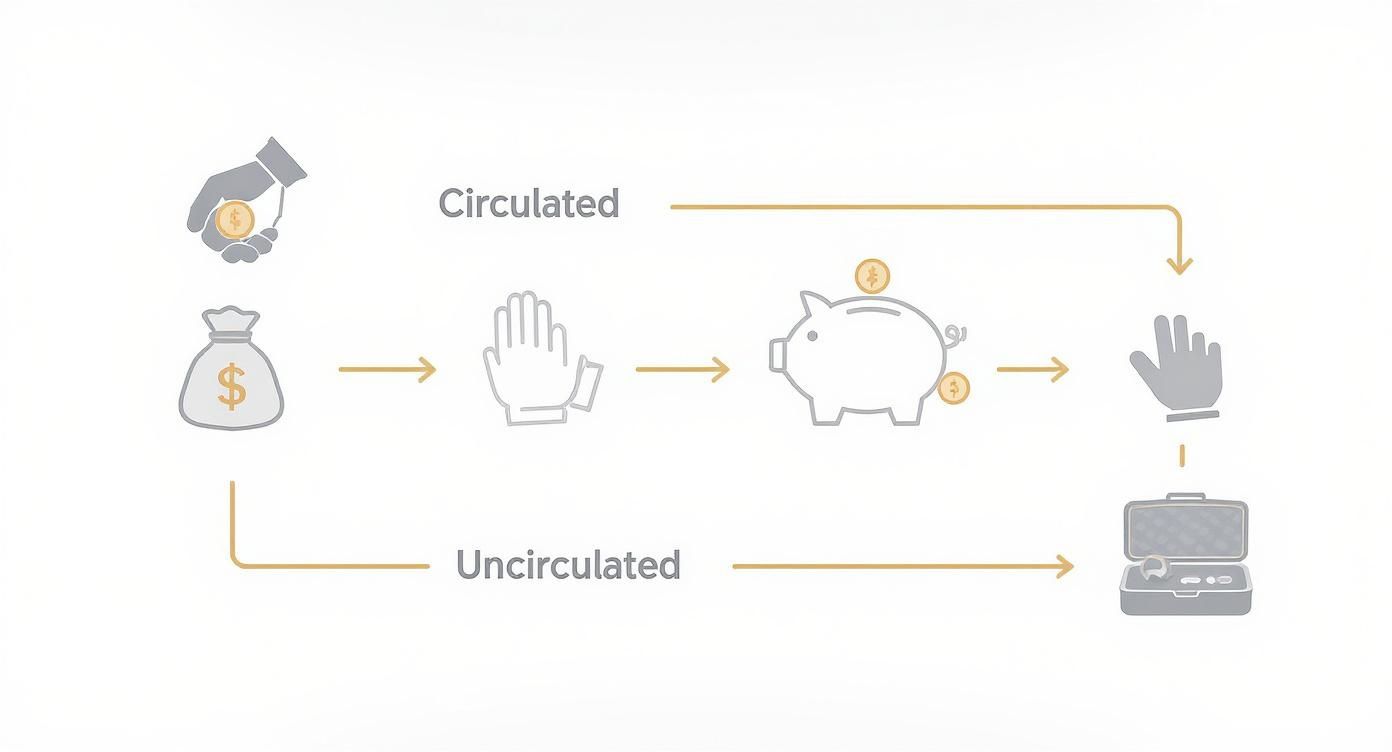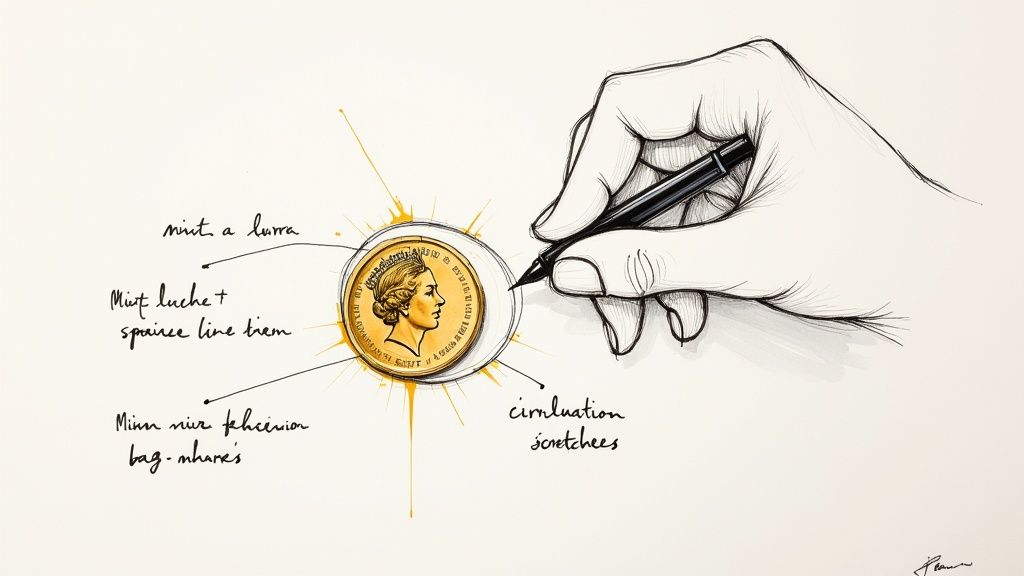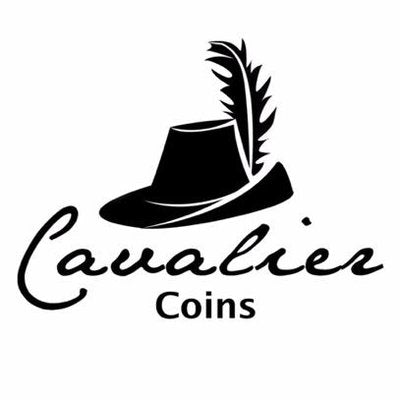Put simply, an uncirculated coin is one that has never been used in everyday transactions. It's never jingled in a pocket, been handed over for a pint of milk, or found its way into a vending machine.
Think of it this way: it’s the difference between a brand-new car sitting pristine in the dealership showroom and one that’s been on the road for a year, picking up the inevitable little scuffs and signs of daily life. For collectors, that untouched, showroom-quality condition is everything.
What Does Uncirculated Actually Mean for a UK Coin?
So, what are we really talking about when we label a UK coin as "uncirculated"? It means the coin has completely bypassed the rough and tumble of public life. Instead of being shipped off to banks and entering the cash cycle, these special coins are carefully preserved the moment they're struck.
This privileged status allows them to hold onto their original mint lustre—that unique, brilliant shine that a coin only has when it's fresh off the minting press. This lustre is incredibly fragile and is one of the first things to vanish once a coin enters circulation, making it a dead giveaway for a true uncirculated piece.
More than that, an uncirculated coin is a perfect snapshot of the artist's original vision.
Every tiny detail, from the intricate lines in the monarch’s portrait to the razor-sharp edges of the lettering, remains crisp and immaculate. It’s a perfect time capsule of its era's art and minting technology.
In the UK, these coins are usually produced by The Royal Mint as either Brilliant Uncirculated (BU) coins or as part of special collector sets. They are struck and handled differently from the coins made to meet public demand. You can learn more about how The Royal Mint manages its coin production on their official website.
To make the distinction crystal clear, here’s a quick rundown of the main differences you’ll find between uncirculated and circulated coins.
Uncirculated vs Circulated Coins at a Glance
| Characteristic | Uncirculated Coin | Circulated Coin |
|---|---|---|
| Condition | Pristine, no signs of wear. | Shows varying degrees of wear and tear. |
| Mint Lustre | Fully intact and vibrant. | Dull or completely absent. |
| Design Details | Sharp, crisp, and complete. | Softened, worn down, or even missing. |
| Surface | Free of major scratches, nicks from use. | May have scratches, dings, and other marks. |
| Origin | Directly from the mint, often in sets. | From public circulation (pockets, tills). |
This table shows why collectors prize uncirculated coins so highly—they are the closest you can get to holding a piece of history exactly as it was intended to be seen.
The Two Journeys of a Brand New Coin
To really get what makes an uncirculated coin so special, picture two brand-new coins, identical twins just struck at The Royal Mint. They start life looking exactly the same, but their paths diverge almost immediately, shaping their future condition and value. For a deeper dive into how they begin, you can explore the fascinating process of how coins are made in our detailed guide.
One of these coins is headed for circulation. It gets tossed into heavy canvas bags with thousands of its siblings, picking up tiny scratches and dings before it has even left the mint. From there, it’s shipped to a bank, run through counting machines, and finally handed to someone at a shop till. This coin will spend its life in pockets, cash drawers, and vending machines, with every transaction slowly dulling its shine and wearing down its sharp details.
The second coin, however, is set aside for a completely different, much more protected life. This is the uncirculated coin.
The Path of a Collector Coin
From the very moment it’s minted, this coin is treated less like currency and more like a work of art. It’s handled carefully, often with gloves, to avoid leaving fingerprints and is quickly sealed in protective packaging. It will never jingle in a pocket or get counted in a bank vault. Instead, its journey is a direct one from the mint to a collector, managed meticulously to preserve its pristine condition.
This infographic shows just how different these two paths are, and why one leads to wear and tear while the other maintains perfection.

The contrast couldn't be clearer. The value of an uncirculated coin lies not just in what it is, but in the rough-and-tumble journey it hasn't taken.
By completely avoiding the harsh realities of public life, the uncirculated coin remains a perfect time capsule. It preserves the mint’s original craftsmanship just as the artist intended. Its lustre is untouched, and its design is as crisp as the day it was created. This careful preservation is what "uncirculated" truly means.
Decoding Uncirculated Coin Grades
Just because a coin is labelled ‘uncirculated’ doesn't mean it’s perfect. It’s a classic rookie mistake to assume they are all created equal, so getting to grips with the terminology is key to knowing exactly what you’re looking at.
In the UK, you’ll very often come across the term Brilliant Uncirculated (BU). This simply describes a standard, machine-fed coin that has never been out in the wild. But even a BU coin can have its little imperfections.
Picture a bucket of freshly minted pennies, hot off the press. As they tumble against each other, they’re bound to pick up small nicks and scratches from all that contact. These are what collectors call ‘bag marks’, and they’re a totally normal feature on BU coins.
Brilliant Uncirculated Versus Proof Coins
It's absolutely vital not to confuse a Brilliant Uncirculated coin with a Proof coin. A Proof coin is in another league entirely, representing a much higher standard of quality. The difference comes down to how they are made:
- Brilliant Uncirculated (BU): Struck just once using standard dies. They are produced in large numbers for collectors and might have minor flaws like those bag marks we mentioned.
- Proof: Struck multiple times using specially prepared, highly polished dies. This meticulous process creates a flawless, mirror-like background that contrasts beautifully with frosted, high-relief design elements.
A Proof coin is the pinnacle of the minting craft—a true masterpiece created for the most discerning collectors. A BU coin, while still pristine and untouched by public hands, is more of a high-quality standard issue.
Take the 2018 £5 coin celebrating the 65th anniversary of Queen Elizabeth II’s coronation, for example. It was issued in Brilliant Uncirculated quality, a finish reserved for coins sold directly to collectors and never intended for tills and pockets. You can discover more about the history of UK commemorative coins and their various finishes.
Understanding these grades is the first real step towards properly assessing a coin's condition and, ultimately, its value. When you're ready to take the next step, our guide on how to get coins graded dives into the details of professional certification. This knowledge gives you the power to confidently interpret the labels and descriptions used by dealers and fellow collectors, making sure you always make informed decisions.
How to Identify an Uncirculated Coin Yourself

Ready to try your hand at grading? With a sharp eye and the right lighting, you can start to spot the tell-tale signs of a truly uncirculated coin. Professional grading takes years to master, of course, but a few simple checks will give you a much better idea of a coin's condition.
The single most important giveaway of an uncirculated coin is its mint lustre. This isn't just a generic shine; it's a specific, satiny radiance that comes straight from the immense pressure of the striking process at the mint.
To see it properly, hold the coin by its edges under a single, bright light. Now, gently tilt it back and forth. A true uncirculated coin will display a fantastic effect where the light seems to spin or cartwheel across its surface. This is because the fresh, microscopic grooves from the die are reflecting the light in a very particular way. A circulated coin, even one that’s barely been handled, will have a flatter, duller reflection because those delicate grooves have already started to wear down.
Checking for Signs of Wear
Once you've had a good look at the lustre, the next step is to hunt for any signs of wear on the highest points of the coin’s design. These are the bits that stick out the most, so they're always the first to show damage if a coin has been rattling around in pockets or tills.
Here are the key areas to inspect closely:
- The Monarch's Portrait: Check the very highest points of the hair, the cheekbone, and the ear for any flatness or loss of detail.
- Lettering and Numbers: Look at the tops of the letters and the date. On an uncirculated coin, they should be crisp and sharp.
- Design Elements: On the reverse, examine the highest-relief parts of the design, like a shield or an animal.
It's crucial to spot the difference between wear from circulation and minor marks from the minting process itself. Wear looks like a smoothing or rubbing away of the design, whereas mint marks are often small, sharp nicks or scratches that happened during production.
By focusing on the lustre and the highest design points, you can build a reliable method for spotting a coin that has never seen circulation. Getting hands-on like this is the best way to truly understand what uncirculated means in practice.
Why Collectors Value Uncirculated Coins

Beyond their brilliant, eye-catching shine, uncirculated coins are highly prized by collectors for reasons that go far deeper than just good looks. Their value is built on a powerful mix of history, investment potential, and the simple joy of collecting.
At its heart, an uncirculated coin is a perfect little time capsule. It captures the original artistry and minting skill of its era, completely untouched by the scrapes and scuffs of daily life. This pristine condition means every tiny detail is exactly as The Royal Mint intended, offering a flawless window into a specific moment in history.
The Foundation of Value
For many, a big part of the appeal is the potential for the coin’s value to grow. Uncirculated coins, particularly those with low mintage numbers or from significant years, can become worth far more than their face value. Their rarity and perfect state make them a tangible asset you can hold in your hand.
Owning an uncirculated coin is like possessing a miniature work of art, untouched by time and commerce. It represents the pinnacle of a coin’s existence, making it a cornerstone for any serious collection.
Beyond their historical and financial appeal, the value of uncirculated coins is also tied to how well they are protected. Many savvy collectors use professional secure storage solutions to shield their most prized pieces from damage, environmental factors, or theft.
Of course, there’s also the pure, personal satisfaction of ownership. Holding a piece of history in its perfect, original state provides a unique feeling that a well-worn coin from your pocket simply can’t match. It’s a direct connection to the past.
It's also important for collectors to know the difference between uncirculated coins and their even more specialised cousins. For those looking to take their knowledge a step further, our guide on what a Proof coin is offers valuable insights into the very highest standards of minting. When you bring all these factors together, you start to see why uncirculated coins are so treasured.
Common Questions About Uncirculated Coins
As you dive deeper into the world of coin collecting, it’s only natural for a few questions to pop up. Making sense of what ‘uncirculated’ truly means is a journey, and getting these common points straight will help you collect with a lot more confidence.
Think of this as your quick-reference guide. We'll get down to the practical side of things, moving from theory to what you'll actually see out in the wild.
Are All Shiny Coins Uncirculated?
This is probably the biggest misconception we see. While an uncirculated coin will always have a shine thanks to its untouched mint lustre, not every shiny coin is uncirculated. A coin can be polished or cleaned to an artificially bright finish, but doing so actually damages its surface and knocks its numismatic value way down.
A cleaned coin often has a flat, lifeless gleam and might show tiny, hairline scratches from whatever was used to scrub it. A true uncirculated coin, on the other hand, has a vibrant, dynamic lustre that seems to cartwheel as you tilt it in the light—a quality that, once it's gone, is gone for good.
Can I Get Uncirculated Coins from a Bank?
It’s highly unlikely, though not completely impossible. Banks get their coins in massive bags straight from the mint, all ready for general use. By the time you get your hands on them, they’ve already been bashed around, handled by countless people, and fed through counting machines, picking up all the little marks that stop them from being truly uncirculated.
You might find a brand-new, just-released coin in your change that looks perfect, but technically, it became a circulated coin the second it hit the banking system. Real uncirculated coins are the ones that have been carefully put aside before this whole process starts.
Does an Uncirculated Coin Have to Be Old?
Not at all. The term ‘uncirculated’ is all about a coin’s condition, not its age. A coin struck yesterday can be uncirculated, just as a coin from the 19th century could be if it was perfectly kept from the day it was made. Age and condition are two totally separate—though equally important—things when figuring out a coin’s value.
Here's a quick rundown of the key differences:
- Uncirculated vs. Proof: Uncirculated coins are made for collectors with a standard strike. Proof coins are struck multiple times with special dies to create a flawless, mirror-like finish.
- Uncirculated vs. Circulated: This is simply a measure of wear. Uncirculated means zero wear from being used; circulated means it has been passed around as money.
- Value and Condition: A coin’s uncirculated status is a massive driver of its value, often more so than its age or face value alone.
Getting these common points sorted will firm up your knowledge and help you avoid making some costly mistakes down the line.
At Cavalier Coins Ltd, we're passionate about helping collectors find authentic, high-quality pieces for their collections. Whether you’re searching for your first Brilliant Uncirculated set or a rare historical piece, our curated selection has something for everyone. Explore our extensive range of coins and banknotes at https://www.cavaliercoins.com.

